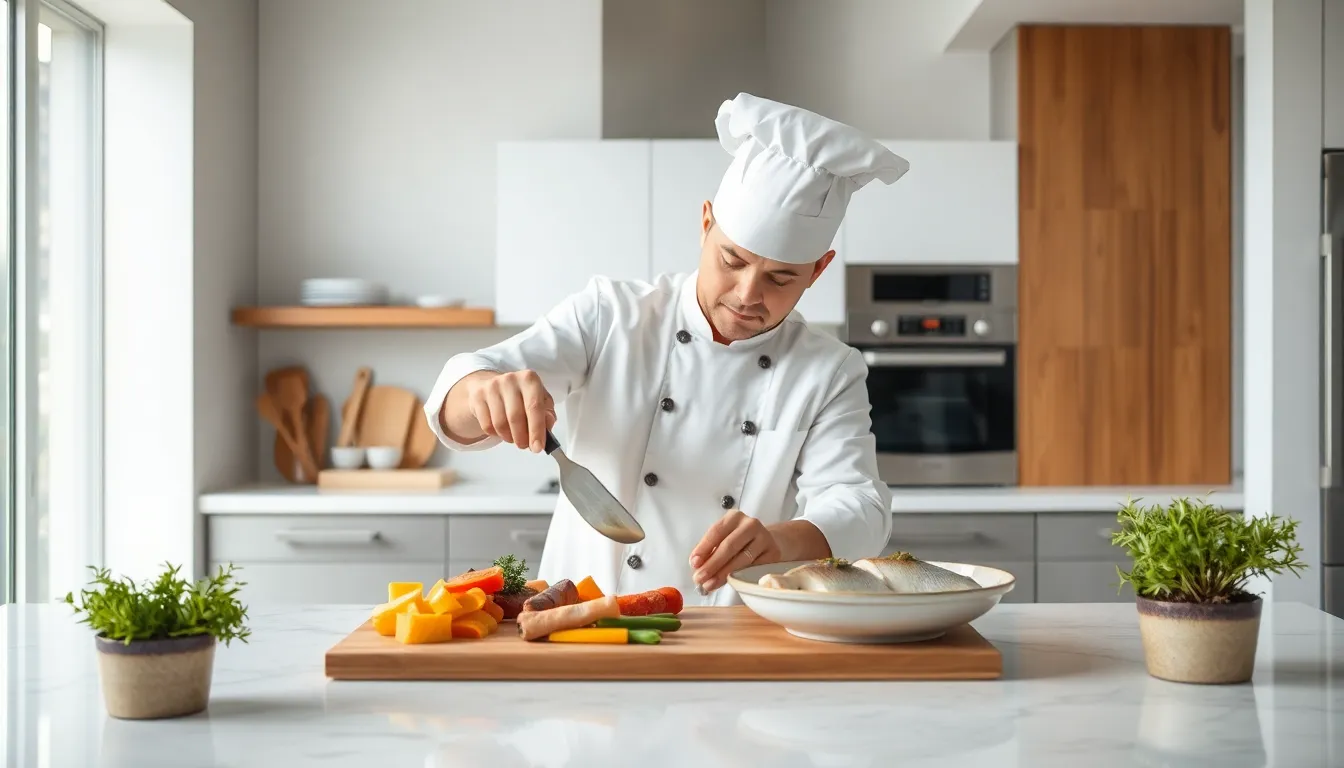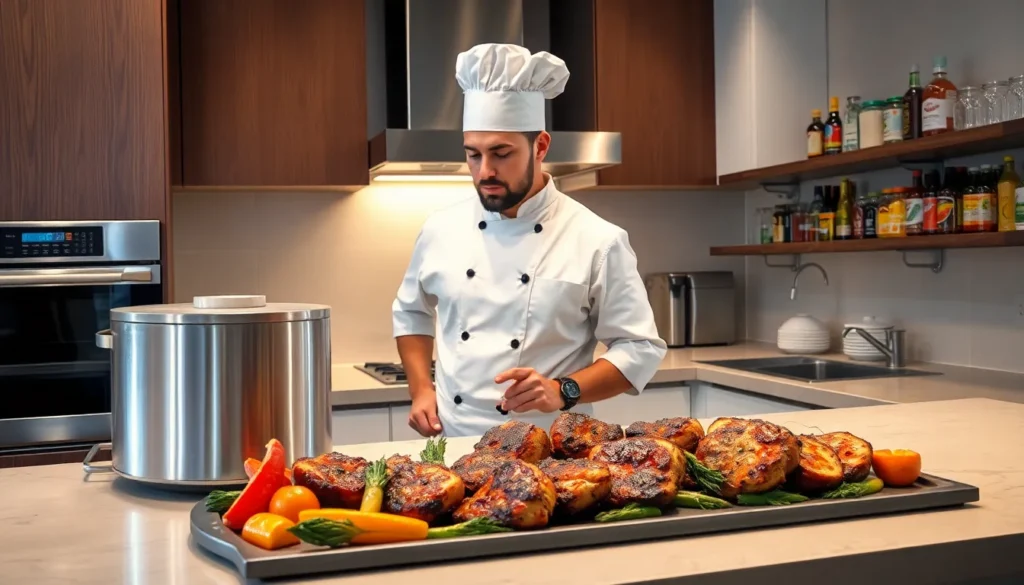In the culinary world, where techniques can often feel like a high-stakes game of chess, combination cooking emerges as the clever strategist. This method blends the best of both worlds—think roasting and steaming teaming up for a delicious duet. It’s like that dynamic duo in your favorite buddy cop movie, where each method brings its unique flair to the table, creating mouthwatering dishes that leave taste buds dancing.
Imagine perfectly tender meat with a crispy exterior, all thanks to this versatile approach. Whether you’re a seasoned chef or a kitchen novice, mastering combination cooking could be your ticket to culinary stardom. So grab your apron and get ready to elevate your cooking game—because who wouldn’t want to impress dinner guests with a meal that’s both smart and scrumptious?
Table of Contents
ToggleWhat Is Combination Cooking Method?
Combination cooking merges several culinary techniques to elevate the quality and flavor of dishes. This method often integrates dry and moist cooking techniques, maximizing the benefits of both. A common example includes the use of roasting alongside steaming to enhance texture and taste.
Heating food through methods like baking or roasting provides a crispy exterior, while steaming retains moisture and ensures tenderness. Chefs achieve perfectly cooked proteins and vegetables by balancing these methods effectively.
Combination cooking proves particularly beneficial for tougher cuts of meat. Cooking them slowly in a moist environment allows collagen to break down, resulting in flavorful, tender outcomes. When combined with a dry technique, the meat edges develop a golden crust that enhances visual appeal.
Mastering this method enhances meal preparation versatility. Utilizing thermometers can help determine ideal cooking times and temperatures, ensuring dishes achieve desired doneness without overcooking. Precise timing plays a crucial role in achieving balance between different cooking techniques.
Combination cooking serves those seeking new flavors and improved cooking efficiency. This versatile approach fits well within various cuisine styles and offering numerous culinary opportunities. Both seasoned chefs and novices can utilize combination cooking to impress diners and elevate everyday meals.
Benefits of Combination Cooking Method

Combination cooking offers numerous advantages, making it a popular choice among chefs. This method enhances the ultimate dining experience through flavor and efficiency.
Enhanced Flavor Profiles
Flavors develop more complex dimensions through combination cooking. Roasting ingredients caramelizes sugars, while steaming maintains moisture. This blend creates a unique taste combination that elevates each dish. For instance, a roast chicken benefits from crispy skin and juicy meat. Seasonings penetrate deeper due to the moisture from steaming. Enhanced flavors often result in dishes that are rich and savory, appealing to diverse palates. Chefs can experiment with herbs and spices, maximizing the taste potential in their creations. By merging cooking techniques, one achieves balanced, mouthwatering flavors.
Time Efficiency
Combination cooking also promotes time efficiency in the kitchen. Multiple techniques can be executed simultaneously, cutting down meal preparation time. For example, one can roast vegetables while simultaneously steaming fish. This method allows for quicker meal assembly without sacrificing quality. Efficient cooking leads to less time spent in the kitchen, making it practical for busy individuals. Under optimal conditions, dishes can be ready in half the time compared to traditional methods. Combining techniques ultimately offers versatility without the hassle of lengthy prep times. Quick and delicious meals become achievable for everyone.
Techniques Involved in Combination Cooking
Combination cooking employs various techniques to maximize flavor and texture in dishes. Two primary methods include sous vide and roasting.
Sous Vide
Sous vide involves vacuum-sealing food in plastic and cooking it in a water bath at a controlled temperature. This technique ensures even cooking, retaining flavors and nutrients. Cooked low and slow, meat becomes tender while achieving precise doneness. Many chefs prefer sous vide for preparing vegetables, as it enhances their natural sweetness and color. It works particularly well for proteins, allowing for consistent results without the risk of overcooking. Utilizing an immersion circulator simplifies the process, enabling chefs to focus on other components of the meal.
Roasting
Roasting primarily utilizes dry heat, creating a deliciously caramelized exterior while retaining moisture inside. This technique enhances flavor, especially in meats and vegetables. Heats circulate in an oven, effectively transferring energy and promoting golden-brown surfaces. Timing plays a crucial role; checking periodically ensures optimal results. Roasting also allows for the use of aromatic herbs and spices, intensifying the dish’s flavor profile. Combining roasting with moist cooking methods adds complexity, making it an excellent choice for preparing tough cuts of meat. This versatility makes it a favorite for various cuisines.
Equipment Needed for Combination Cooking
Combination cooking requires specific equipment to maximize its effectiveness. A sous vide machine is essential, offering precise temperature control for even cooking. An immersion circulator serves the same purpose, allowing for water bath cooking techniques.
Ovens with convection settings enhance the roasting process, promoting even heat distribution. Cast iron skillets or Dutch ovens are great for both roasting and stovetop cooking, providing versatility in meal preparation. Multipurpose instant pots or pressure cookers can also create a combination of steaming and sautéing, making them invaluable for busy kitchens.
Thermometers ensure accurate temperature readings, crucial for achieving optimal doneness in meats and vegetables. High-quality knives and cutting boards streamline food prep, ensuring that ingredients are ready for cooking without delays. Non-stick baking sheets or roasting pans facilitate easy cleanup and prevent sticking during cooking processes.
Use steaming racks when preparing foods that require moist heat, allowing steam to circulate evenly. Silicone mats are another useful addition, offering a non-stick surface while roasting or baking.
Blenders or food processors enhance flavor development by easily mixing marinades or purees, which can be used in combination with cooked dishes. Each piece of equipment plays a pivotal role in creating the perfect environment for combination cooking, ensuring consistent results with various dishes.
Tips for Successful Combination Cooking
Prioritize timing to ensure optimal results with combination cooking. Monitor cooking durations closely, as overlapping methods can lead to overcooked dishes. Keep a reliable thermometer handy; it offers precise temperature readings, ensuring meats reach the desired doneness without sacrificing moisture.
Combine flavors thoughtfully by using aromatic herbs and spices during the process. Incorporating these not only enhances taste but also elevates the overall dish. Select complementary ingredients for steaming and roasting, maximizing flavor development and texture.
Utilize the right equipment for superior outcomes. A sous vide machine guarantees controlled temperatures, while a convection oven improves roasting efficiency. Non-stick baking sheets and steaming racks simplify cleanup, making the entire process smoother.
Experiment with various cooking techniques, adjusting methods based on the dish being prepared. Some dishes benefit from longer sous vide cooking followed by a quick roast for crispness. Understanding how to blend techniques leads to richer flavor profiles.
Incorporate moisture wisely when using dry heat methods. Adding a small amount of liquid during roasting keeps proteins tender while achieving a crispy exterior. Balancing moisture and heat creates a pleasing texture in final dishes.
Stay organized throughout the cooking process to manage multiple techniques effectively. Preparing ingredients before firing up appliances helps maintain focus and timing. This preparation ensures flavors meld well and cooking proceeds seamlessly.
Combination cooking opens up a world of culinary possibilities. By blending different techniques like roasting and steaming, it enhances flavors while ensuring optimal textures. This method not only makes meals more enjoyable but also saves time in the kitchen, making it a perfect fit for busy lifestyles.
With the right tools and a bit of practice, anyone can master this approach. Experimenting with flavors and timing can lead to delicious results that impress family and friends. Embracing combination cooking allows for creativity and innovation in the kitchen, elevating everyday meals into extraordinary experiences.





